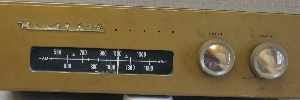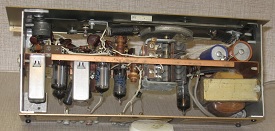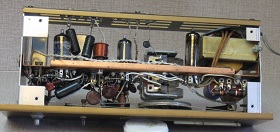Vintage Audio: Heath BC-1A AM tuner | Telos Alliance
By The Telos Alliance Team on Jan 28, 2015 12:09:00 PM
 Vintage Tech: Heath BC-1A AM tuner
Vintage Tech: Heath BC-1A AM tuner
The debate about high-quality AM signals vs. adjacent channel interference and occupied bandwidth has been going on longer than most of us have been alive. One of the sticking points was always the issue of 'who goes first?' Station engineers were reluctant to spend the time, money and energy to perfect their signal, only to have it trashed by receivers with misaligned 5 Khz IF stages and a 3-inch speaker. Receiver manufacturers, on the other hand, didn't want to build high-fidelity AM radios when most of the stations sounded like crap anyway.
There were exceptions on both sides of the aisle. With its classical music format, WQXR-AM at 1560 Khz in New York had a sound that rivaled, or even surpassed, many FM stations. CKLW, at 800 Khz, is often recalled as a Top 40 station with audio quality second to none.
On the receiver side, the McKay Dymek AM 5 is remembered as one of the finest sounding AM radios of the 1980s. The GE Superadio was popular in the ‘90s. This month's attic treasure is a wide band AM receiver from an earlier decade, a 1958 Heathkit BC-1A AM tuner.
The BC-1A sold in kit form for around $25.00. Despite the low price, it was designed for high fidelity AM reception. The frequency response is flat out to 9 Khz. A bit of high-frequency pre-emphasis is employed to give the impression of an even better high end response. The design was optimized for best response of strong local stations, at the expense of slightly reduced sensitivity. A 10 Khz bridged-T notch filter was included on the audio output to reduce interstation whistle interference.
Sideband interference could also be a problem in metropolitan areas. The BC-1A came with a low-impedance, two turn loop antenna, so that the interfering station could be nulled out. In extreme cases, a resistor could be changed in order to reduce bandwidth. The terminal strip on the back had connections for both the loop antenna and a conventional long wire.
Much of the BC-1A's circuitry is conventional, but there are a few exceptions. The IF strip in most AM radios is narrow band or sharply tuned, which greatly attenuates the higher frequency sidebands. Typically the response is down about 50% at 6 Khz.
The first IF stage on the BC-1A is an over-coupled wideband device, giving a bandwidth of about 19 Khz. The twin peaks in the response of this transformer would be quite non-linear by themselves. The second IF transformer, however, is tuned to a sharp peak to fill in the valley in the middle of the input transformer's response. The net result is an overall response that is flat out to 9.5 Khz on each side of the 455 Khz center frequency.
An over-coupled input IF transformer is uncommon in most AM receivers, but it is a high-impedance device, yielding a steep slope on each side of the IF curve. This provides substantial attenuation of adjacent channel carriers 10 Khz away, as well as assisting the 10 Khz whistle filter on the audio output.
The BC-1A has the old civil defense logo on the dial at 640 and 1240 Khz, indicating it was built during the days of the Cold War and CONELRAD (CONtrol of ELectrotmagnetic RADiation). CONELRAD was the original system for alerting the public to nuclear attack or emergencies, and it was introduced in 1951. The intent was twofold – to provide emergency information in the event of nuclear attack, and to deny enemy bombers the use of AM broadcast frequencies as homing beacons to major cities.
In order to do this, in emergencies, all AM broadcasters either had to sign off, or switch frequency to 640 or 1240 Khz. Having every station on one of these two frequencies would make it impossible for them to be used for direction finding. At the same time, the FCC required all radio manufacturers to mark AM radio dials with the Civil Defense logo on 640 and 1240 Khz, so that listeners would know where to tune in the event of a nuclear attack.
CONELRAD was replaced in August of 1963 by the Emergency Broadcast System (EBS). This radio dial, however, brings back dark memories of the days when students in public schools had to practice 'duck and cover' drills to be ready for a nuclear blast.
This BC-1A was found in the trash in a 'student ghetto' of Boston, Mass. around 1980. Sadly, the loop antenna was no longer with the radio. When cleaned up and plugged in, it worked – sort of. It had great sound and good reception on the high end of the dial. Around 600 Khz however, everything went silent.
This suggested a short in the tuning condenser. A careful examination revealed nothing, but the spacing between plates on the tuning condenser is pretty close. Blasting it out with compressed air didn't help. Carefully working a plastic ID card between the plates at each end did. Now the tuner worked on the entire band.
Next, it had all the tubes checked, received new electrolytic caps, and had the RF, IF and 10 Kc circuits aligned, although they were pretty close to begin with. Socket voltages were checked, and all compared favorably with the schematic.
 A shielded loop antenna was fabricated from old plans in Popular Electronics. As expected, it was great for nulling out interference on the crowded dial, but frequent adjustments of the antenna when switching stations became tedious.
A shielded loop antenna was fabricated from old plans in Popular Electronics. As expected, it was great for nulling out interference on the crowded dial, but frequent adjustments of the antenna when switching stations became tedious.
At the time, there were still a few good music stations on the AM dial in Boston, so the BC-1A became the shop radio for a few years. This radio gave great service and hours of listening pleasure. Eventually, it was wrapped up and packed away, to be undisturbed for 35 years. It still works, but the likelihood of finding any AM stations playing high-fidelity music seems slim. It will most likely be put on display, as a remembrance of the days when AM radio truly rocked.
Telos Alliance has led the audio industry’s innovation in Broadcast Audio, Digital Mixing & Mastering, Audio Processors & Compression, Broadcast Mixing Consoles, Audio Interfaces, AoIP & VoIP for over three decades. The Telos Alliance family of products include Telos® Systems, Omnia® Audio, Axia® Audio, Linear Acoustic®, 25-Seven® Systems, Minnetonka™ Audio and Jünger Audio. Covering all ranges of Audio Applications for Radio & Television from Telos Infinity IP Intercom Systems, Jünger Audio AIXpressor Audio Processor, Omnia 11 Radio Processors, Axia Networked Quasar Broadcast Mixing Consoles and Linear Acoustic AMS Audio Quality Loudness Monitoring and 25-Seven TVC-15 Watermark Analyzer & Monitor. Telos Alliance offers audio solutions for any and every Radio, Television, Live Events, Podcast & Live Streaming Studio With Telos Alliance “Broadcast Without Limits.”
Recent Posts
Subscribe
If you love broadcast audio, you'll love Telos Alliance's newsletter. Get it delivered to your inbox by subscribing below!